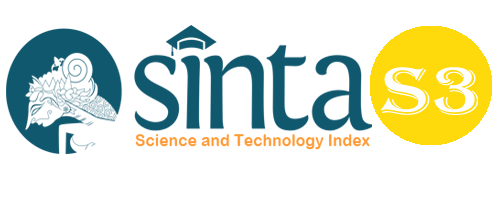Enhance Web-Based Job Search Recommendation System of Hybrid-Based Recommendation
Abstract
The main activity carried out daily for an individual to earn money is by working. Finding a job that matches our educational background is not easy. Many individuals do not know their abilities and the limited information on job vacancies is also an obstacle for applicants who want to find work. Therefore, a 'toolkit is needed that can provide recommendations on what fields of work are by the educational background in question. The hybrid approach method is to combine collaborative-filtering techniques (decision tree algorithm) and content-based (nearest neighbor algorithm). The decision tree algorithm is used to classify the fields of work while for job recommendations, the nearest neighbor algorithm is used. In the nearest neighbor, the similarity formula is used to calculate the proximity between applicants and job vacancies based on matching the existing weights and attributes. The output generated from this system is a list of job recommendations that match the applicant's educational background.
Keywords
Full Text:
PDFReferences
Beynon-Davies. P. 2004. Database System: Third Edition. Palgrave, Basingstoke: United Kingdom.
Frias-Martinez, E., Magoulas, G., Chen, SY, and Macredie, R. 2006. Automated user modeling for personalized digital libraries, International Journal of Information Management, Vol. 26. pp.234–248.
Hayati, N. 2011. HYBRID (Content and Collaborative based) Nearest Neighbor method for tourism recommendation system. Thesis, University of North Sumatra, Medan.
Herlocker, JL, and Konstan, JA 2001. content Independent Task-Focused Recommendation, IEEE Internet Computing, Vol. 5, 2001, pp. 40-47
Mahmood, T., Ricci, F. 2009. Improving recommender systems with adaptive conversational strategies. In: C. Cattuto, G. Ruffo, F. Menczer (eds.) Hypertext, pp. 73–82. ACM
Mellville, P and Sindhwani, V. 2010. Recommender Systems: Encyclopedia of machine learning ch:00338. IBM research center
Pudjiantoro, T. Renaldi, F. and Teogundi, A. 2011. Application of Data Mining to analyze the possibility of new student resignations. Thesis, Bali
Setiawan, B. 2010. Designing a Decision Support System (SPK) to determine Ship's Seaworthiness.
Sembiring, A.S., et al. (2019). Character Formation Based on North Sumatra Local Wisdom Through Orchestral Learning in Music Education Study Program, Universitas Negeri Medan. Budapest International Research and Critics Institute- Journal (BIRCI-Journal). 315-325.
Siregar, S.F., Mardianto and Ahkas, A.W. (2020). Extracurricular Implementation of Islamic Education in Character Building Students in MTs EX PGA UNIVA Medan. Budapest International Research and Critics in Linguistics and Education (BirLE) Journal. P. 965-973.
Utgoff, PE 1989. ID5: Incremental induction of decision trees, Machine Learning, Vol. 4, No. 2, pp. 161-186.
Vaidehi, V and Vasuhi, S. 2008. Person Authentication using Face Recognition, Proceedings of the world congress on egg and computer science pp 1-6.
Xu, Y. Zhu, Q. Chen, Y and Pan JS. 2013. An Improvement to the Nearest Neighbor Classifier and Face Recognition Experiments: International Journal of Innovative Computing, Information and Control Vol 9 no 2 pp 543-554.
DOI: https://doi.org/10.33258/birci.v4i3.2579
Article Metrics
Abstract view : 89 timesPDF - 43 times
Refbacks
- There are currently no refbacks.

This work is licensed under a Creative Commons Attribution-ShareAlike 4.0 International License.

This work is licensed under a Creative Commons Attribution-ShareAlike 4.0 International License.

_.gif)

















_.gif)



